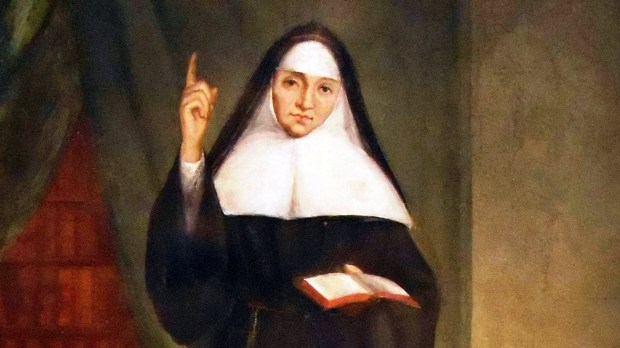Lenten Campaign 2025
This content is free of charge, as are all our articles.
Support us with a donation that is tax-deductible and enable us to continue to reach millions of readers.
Marie Guyart was born October 28, 1599, in Tours, France. By the time Marie was 14, she had already asked her parents if she could enter the convent. In one of her letters that was published in 1654, she wrote that she had experienced a visit from Jesus when she was 7 years old. She wrote that Jesus had come to her, reached out, put His arms around her, and hugging her said, “Do you wish to belong to Me?”
She says she told Him loudly, “YES!” Marie also wrote in her book that from that point forward she could only think of “Goodness.”
Young widow called to the spiritual life
Although Marie constantly spoke of becoming a religious, her parents betrothed her to a man named Claude Martin. When she was 18, Marie did as her folks wanted and married him. The couple had a son, but Claude died when the boy was only six months of age. Marie was 20. The year was 1619 and Marie was suddenly a young widow with a baby to raise.
She then moved in with her sister and brother-in-law, Paul Buisson. Paul owned a thriving transportation business, and Marie began working for him. She possessed great organizational skills and soon took over management of the Buisson business. However, over the ensuing 10 years, her primary focus and desire again became entering the spiritual life.
When Claude Jr. reached his teen years, Marie began making plans to enter the Ursuline order, as her sister promised to care for her son as if he were her own. Marie was heartbroken to leave young Claude, but she believed that he would thrive with her sister and Paul, who also treated the boy as his own. Those factors sealed her decision to become a nun.
Called to Canada
Marie joined the Ursuline order in 1632. She received the name of Mother Marie of the Incarnation.
Sometime during 1636, Mother Marie had a vision of a beautiful place filled with mountains and forests and lakes. She was told that this place was Canada (then known as New France), and she was supposed to go there and build a house for Jesus. It took her several years, but she managed to raise the necessary funds.
Mother Marie garnered the support of the Jesuits. She was given the charter to establish centers in New France by none other than Louis XII. On April 3, 1639, she and two other Ursulines set sail for a land she had never seen but only dreamed of.
They arrived in Quebec on August 1, 1639. Mother Marie and her companions immediately set about doing missionary work by attending to the many native peoples in the area. Soon several more Ursuline nuns joined them, and the nuns moved into a small house donated to them for use as a convent. By 1642 the nuns had managed to have a permanent stone building built. It became the first school in Canada and was known as the Ursuline Monastery of Quebec. (Today the building is one of the National Historic Sites of Canada.)
An active vocation
Mother Marie’s unique management skills enabled her to organize the new school and convent into a functional and efficient operation. There were Iroquois, Algonquin, Montagnais, and Ouendat natives in the area and Mother Marie worked with the Jesuits and learned their languages, even writing dictionaries in all the languages. Slowly but surely women began joining the order.
Ten years after Marie had entered the Ursuline order, her son, Claude, had become a Benedictine monk. Mother and son kept in frequent contact, and when Marie left for Canada, they kept up a regular correspondence with each other and this continued for more than 30 years.
Mother Marie of the Incarnation passed away on April 30, 1672. She had spent 33 years in the Canadian wilderness.
In a biography he wrote of his mother, Claude said:
“Her zeal for the salvation of souls, and especially for the conversion of the Indians, was great and so universal that she seemed to carry them all in her heart. We cannot doubt that, by her prayers, she greatly called down God’s many blessings upon this new-born Church.”
Mother Marie of the Incarnation is recognized as one of the primary reasons Catholicism grew and flourished in Canada. There is even a statue in her honor standing in front of the Quebec Parliament. Her voluminous letters also give us a look at the people who worked to spread the Catholic faith in the region — including valuable information about the eight North American martyrs, who she personally knew.
St. Marie of the Incarnation was canonized by Pope Francis on April 2, 2014. We ask her to please pray for us all.



